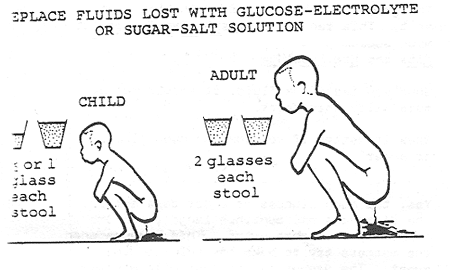Slide 18
Home made oral Fluids, and how much
to giveHere you can see someone making up a glass
of OR fluid.
Teacher's Note
Stop at each of the following four questions and ask students to give their answers. This
checks that they understood="diarrhoea-management-17.htm" target="_blank"> Slide
17, and reinforces the information already given. The
fifth question, about the advantages of the
spoon, could be a useful discussion topic. |
Q. What volume of water did we say that this glass
contains approximately?
A. This glass contains approximately 200 ml. of
water. After mixing in sugar and salt, fill up the
glass to the top with water.
Q. Which end of the spoon is for the sugar, and which
for the salt?
A. The large 'scoop' (which is in the water) is for
sugar. The small 'scoop' (in the air) is for salt.
Q. What is the most serious danger if you make up the
fluid wrongly?
A. The greatest danger is of adding too much salt.
This can cause hypernatraemia (or too much
sodium in the blood) which cause fits and brain damage.
When you taste the fluid, it should not be more
salty than tears.
Q. Does it matter if you add too much glucose or
sugar?
A. Yes, too much glucose or sugar does matter. The
diarrhoea may continue longer, and the child may
lose more water. This happens when the mothers
try to make the solution very sweet. The danger is
greatest with glucose because you need more
glucose than sugar to make something taste sweet.
Q. What are the disadvantages and the advantages of
using this measuring spoon, compared with using packets of ORS?
A. The disadvantages of the spoon are that it only
measures two of the four chemicals in ORS so it
does not give you a "complete replacement fluid".
And there is a risk that people may use it wrongly
and measure salt with the big scoop. Packets of
ORS are already measured for you. An advantage
of the spoon is that it should keep longer than
packets of ORS - so you can always make OR fluid
even when medicines are out of stock. Also, the
spoon is interesting and memorable. This may
have important educational value. The spoon
reaches and reminds health workers and mothers
about giving OR fluid, and about what to put in it.
Teacher's Note
You should have a demonstration spoon with
these slides. Get some sugar and salt and
water and some glasses and ask students to
make the OR solution for themselves, using
the spoon. If possible, bring several different
kinds of glass and cup, and a fluid measure,
and check the volume of each glass and cup.
Notice which ones contain less than 200 ml.
Then, ask students to measure salt and sugar
with the spoon. Make up the solution and taste
it. It should not taste more salty than tears. If
some students use the big scoop for salt - let
them finish - then compare the taste of this 'dangerous' fluid yourself. Make a row of
glasses of OR solutions, some correct, some
too dilute, and some too salty. Ask the
audience to decide between "salty", "dilute",
and "correct". At the same time let them make
up 1 litre of solution using 3-finger pinches of
salt and 4-finger scoops of sugar.
Whoever mixes and gives OR solution should taste it
before feeding it to a child. |
Figure 7 (From Slide
19) - Replace Fluids Lost with Glucose-Electrolyte or
Sugar-Salt Solution
